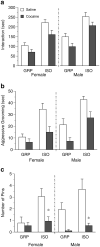Effects of cocaine combined with a social cue on conditioned place preference and nucleus accumbens monoamines after isolation rearing in rats
- PMID: 24553577
- PMCID: PMC4646085
- DOI: 10.1007/s00213-014-3470-0
Effects of cocaine combined with a social cue on conditioned place preference and nucleus accumbens monoamines after isolation rearing in rats
Abstract
Rationale: Social interaction during drug exposure can potentiate cocaine reward. Isolation rearing (ISO) during adolescence increases social interaction and may amplify this potentiation.
Objectives: The objectives of this study are to determine whether ISO alters conditioned place preference (CPP) for cocaine when combined with a social cue and to determine whether ISO alters the effects of cocaine when combined with social cue on nucleus accumbens shell (NAcS) dopamine (DA) and serotonin (5-HT).
Methods: Male and female rats were either ISO or group (GRP) reared for 4 weeks during adolescence. CPP was performed using a low dose of cocaine (2 mg/kg or saline) with or without exposure to a novel same-sex conspecific during conditioning. In vivo microdialysis was performed using the same parameters.
Results: ISO rats engaged in more social and aggressive behaviors during conditioning relative to GRP. Cocaine reduced social and aggressive behaviors in all rats. CPP was not influenced by rearing condition. Cocaine produced significant CPP, and a social cue produced CPP only in males. In contrast, the interaction of cocaine and a social cue on NAcS DA and 5-HT differed depending upon rearing condition. In isolates, cocaine-induced DA was attenuated, while cocaine plus a social cue produced potentiated DA and 5-HT.
Conclusions: Exposure to a low dose of cocaine in the presence of a social cue produced additive effects on CPP while producing synergistic effects on DA and 5-HT in the NAcS of ISO rats. The aversive effects of this compound stimulus may negate the rewarding effects in isolates.
Conflict of interest statement
Figures







Similar articles
-
Social interaction reward decreases p38 activation in the nucleus accumbens shell of rats.Neuropharmacology. 2015 Dec;99:510-6. doi: 10.1016/j.neuropharm.2015.08.029. Epub 2015 Aug 20. Neuropharmacology. 2015. PMID: 26300300 Free PMC article.
-
The effects of prenatal cocaine, post-weaning housing and sex on conditioned place preference in adolescent rats.Psychopharmacology (Berl). 2014 Apr;231(8):1543-55. doi: 10.1007/s00213-013-3418-9. Epub 2014 Jan 17. Psychopharmacology (Berl). 2014. PMID: 24435324 Free PMC article.
-
5-HT(1B) receptors in nucleus accumbens efferents enhance both rewarding and aversive effects of cocaine.Eur J Neurosci. 2007 May;25(10):3125-31. doi: 10.1111/j.1460-9568.2007.05568.x. Epub 2007 May 17. Eur J Neurosci. 2007. PMID: 17509084
-
Dyadic social interaction inhibits cocaine-conditioned place preference and the associated activation of the accumbens corridor.Behav Pharmacol. 2015 Sep;26(6):580-94. doi: 10.1097/FBP.0000000000000167. Behav Pharmacol. 2015. PMID: 26221832 Free PMC article. Review.
-
Dyadic social interaction as an alternative reward to cocaine.Front Psychiatry. 2013 Sep 12;4:100. doi: 10.3389/fpsyt.2013.00100. Front Psychiatry. 2013. PMID: 24062696 Free PMC article. Review.
Cited by
-
A novel escapable social interaction test reveals that social behavior and mPFC activation during an escapable social encounter are altered by post-weaning social isolation and are dependent on the aggressiveness of the stimulus rat.Behav Brain Res. 2017 Jan 15;317:1-15. doi: 10.1016/j.bbr.2016.09.025. Epub 2016 Sep 12. Behav Brain Res. 2017. PMID: 27633556 Free PMC article.
-
Gamma-Aminobutyric Acidergic Projections From the Dorsal Raphe to the Nucleus Accumbens Are Regulated by Neuromedin U.Biol Psychiatry. 2016 Dec 1;80(11):878-887. doi: 10.1016/j.biopsych.2016.02.031. Epub 2016 Mar 8. Biol Psychiatry. 2016. PMID: 27105831 Free PMC article.
-
Sex-dependent regulation of social reward by oxytocin receptors in the ventral tegmental area.Neuropsychopharmacology. 2019 Mar;44(4):785-792. doi: 10.1038/s41386-018-0262-y. Epub 2018 Nov 6. Neuropsychopharmacology. 2019. PMID: 30467338 Free PMC article.
-
Monoacylglycerol lipase inhibition alters social behavior in male and female rats after post-weaning social isolation.Behav Brain Res. 2018 Apr 2;341:146-153. doi: 10.1016/j.bbr.2017.12.038. Epub 2017 Dec 29. Behav Brain Res. 2018. PMID: 29292159 Free PMC article.
-
Sex-dependent regulation of social reward by oxytocin: an inverted U hypothesis.Neuropsychopharmacology. 2019 Jan;44(1):97-110. doi: 10.1038/s41386-018-0129-2. Epub 2018 Jun 23. Neuropsychopharmacology. 2019. PMID: 29968846 Free PMC article. Review.
References
-
- Auclair AL, Cathala A, Sarrazin F, Depoortere R, Piazza PV, Newman-Tancredi A, Spampinato U. The central serotonin 2B receptor: a new pharmacological target to modulate the mesoaccumbens dopaminergic pathway activity. J Neurochem. 2010;114:1323–1332. - PubMed
-
- Bland ST, Twining C, Watkins LR, Maier SF. Stressor controllability modulates stress-induced serotonin but not dopamine efflux in the nucleus accumbens shell. Synapse. 2003;49:206–208. - PubMed
-
- Bland ST, Schmid MJ, Watkins LR, Maier SF. Prefrontal cortex serotonin, stress, and morphine-induced nucleus accumbens dopamine. Neuroreport. 2004;15:2637–2641. - PubMed
Publication types
MeSH terms
Substances
Grants and funding
LinkOut - more resources
Full Text Sources
Other Literature Sources

